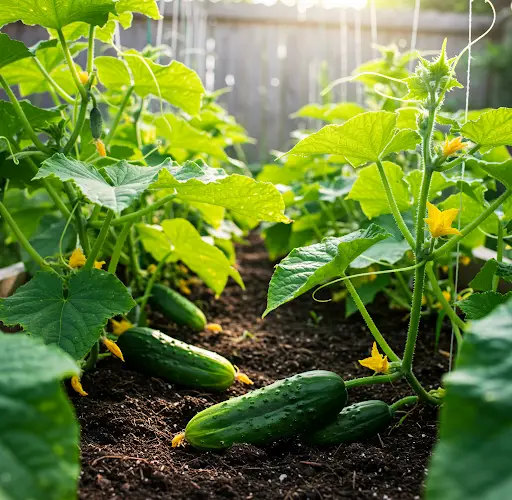How to Grow Cucumbers for Quick Harvests, Abundant Yields, and Crispy Fruits
Cucumbers are a favorite among home gardeners due to their refreshing taste, high yield, and nutritional benefits. Whether you love eating them fresh, pickled, or in salads, growing cucumbers the right way will ensure you get quick harvests, lots of fruit, and incredibly crispy cucumbers. By following simple but effective growing techniques, you can enjoy an abundant supply of cucumbers all season long. In this guide, we’ll share the best methods for growing cucumbers successfully at home.
Why Grow Cucumbers at Home?
- Faster Harvests – Some cucumber varieties can be harvested in as little as 45-60 days.
- Better Taste – Homegrown cucumbers are fresher and crunchier than store-bought ones.
- High Yield – A single plant can produce dozens of cucumbers with proper care.
- Cost-Effective – Saves money compared to buying cucumbers from the market.
- Chemical-Free – No harmful pesticides or artificial growth stimulants.
Best Cucumber Varieties for Home Growing
Choosing the right cucumber variety is key to getting quick and abundant harvests. Here are some great options:
- Bush Cucumbers – Ideal for small spaces and container gardening.
- Vining Cucumbers – Grow on trellises and yield more fruit per plant.
- Pickling Cucumbers – Perfect for making homemade pickles.
- Slicing Cucumbers – Large and crisp, best for fresh eating.
- Burpless Cucumbers – Sweeter, with thinner skin and fewer seeds.
The Best Methods for Growing Cucumbers
1. Growing Cucumbers in Raised Beds for Faster Growth
Raised beds improve soil drainage, warmth, and aeration, which helps cucumbers grow faster and healthier.
Steps to Grow Cucumbers in Raised Beds:
- Build a raised bed at least 12 inches deep.
- Fill with a nutrient-rich, well-draining soil mixed with compost.
- Plant cucumber seeds or seedlings 12 inches apart.
- Mulch around plants to retain moisture and prevent weeds.
- Water regularly, keeping soil moist but not soggy.
2. Vertical Gardening for More Cucumbers in Less Space
Cucumbers love to climb, and growing them vertically helps improve airflow, reduce disease risk, and make harvesting easier.
How to Grow Cucumbers Vertically:
- Install trellises, cages, or stakes to support vines.
- Train vines to grow upwards by tying them to the trellis.
- Prune excess leaves to allow sunlight and airflow to reach fruits.
- Harvest regularly to encourage more fruit production.
3. Container Gardening for Compact Spaces
If you have limited space, growing cucumbers in large containers (5 gallons or more) is a great option.
Key Tips for Growing Cucumbers in Containers:
- Use a well-draining potting mix with compost.
- Place containers in a sunny location (at least 6-8 hours of direct sunlight daily).
- Water deeply and regularly to keep the soil consistently moist.
- Fertilize with a balanced fertilizer every 2-3 weeks.
- Support vines with a trellis if growing vining cucumber varieties.
4. Direct Sowing vs. Transplanting
- Direct Sowing – Cucumbers grow best when planted directly in the soil as they don’t like root disturbance.
- Transplanting Seedlings – If starting indoors, use biodegradable pots to avoid transplant shock.
5. Companion Planting for Healthier Cucumbers
Growing cucumbers with companion plants can boost growth, repel pests, and improve soil health.
Best Companion Plants for Cucumbers:
- Basil & Dill – Enhance flavor and repel pests.
- Radishes – Deter cucumber beetles.
- Lettuce & Spinach – Use space efficiently.
- Marigolds & Nasturtiums – Protect cucumbers from harmful insects.
Caring for Your Cucumber Plants
1. Watering for Juicy, Crisp Cucumbers
Cucumbers are made up of about 95% water, so proper watering is crucial.
- Water deeply 2-3 times per week, keeping soil moist but not soggy.
- Use drip irrigation or watering at the base to prevent fungal diseases.
- Avoid overhead watering, as wet leaves can lead to powdery mildew.
2. Pruning for Maximum Yield
Pruning helps focus energy on fruit production and prevents overgrowth.
- Remove lower leaves to improve airflow and reduce disease risk.
- Pinch off excess flowers to encourage bigger, healthier cucumbers.
- Regularly remove dead or yellowing leaves.
3. Fertilizing for Rapid Growth
- Use an organic balanced fertilizer (10-10-10) every 3 weeks.
- Boost fruit production with compost tea or liquid seaweed fertilizer.
- Add calcium (crushed eggshells) to prevent blossom end rot.
Common Cucumber Problems and How to Fix Them
| Problem | Cause | Solution |
|---|---|---|
| Yellowing Leaves | Overwatering or lack of nutrients | Adjust watering, add compost |
| Small or Misshapen Cucumbers | Pollination issues or inconsistent watering | Hand-pollinate, maintain even moisture |
| Bitter Cucumbers | High temperatures or drought stress | Provide shade, water consistently |
| Powdery Mildew | Too much moisture and poor airflow | Space plants properly, use neem oil |
| Cucumber Beetles | Pests attacking leaves and fruit | Use row covers, plant marigolds nearby |
Harvesting and Storing Cucumbers for Maximum Freshness
Cucumbers grow quickly, so frequent harvesting encourages more fruit production.
When to Harvest Cucumbers:
- Pick cucumbers when they are 6-8 inches long for best taste.
- For pickling cucumbers, harvest at 3-5 inches.
- Don’t let cucumbers become too large, as they turn bitter and seedy.
How to Store Cucumbers:
- Store in a cool, dry place for short-term use.
- Keep in the refrigerator wrapped in a paper towel to stay crisp.
- Do not store near fruits like bananas or apples (they release ethylene gas which can spoil cucumbers faster).
Final Thoughts
Growing crisp, sweet, and abundant cucumbers is easy when you follow the right methods. Whether you’re using raised beds, trellises, containers, or direct sowing, proper care and attention to watering, fertilizing, and pruning will ensure a successful harvest. Try these techniques and enjoy fresh, homegrown cucumbers that taste better than anything you can buy in the store.
Start your cucumber garden today and experience the joy of homegrown, chemical-free produce!
Happy Gardening!



